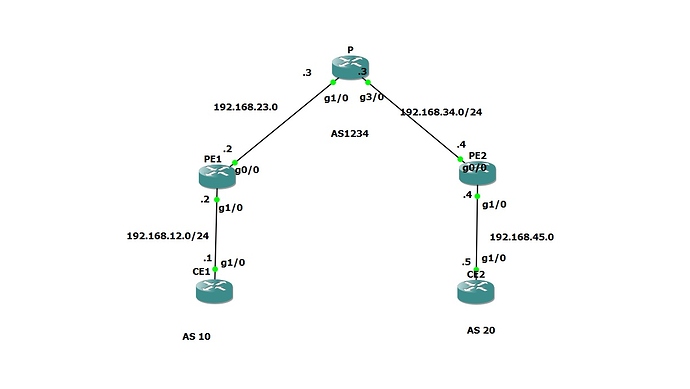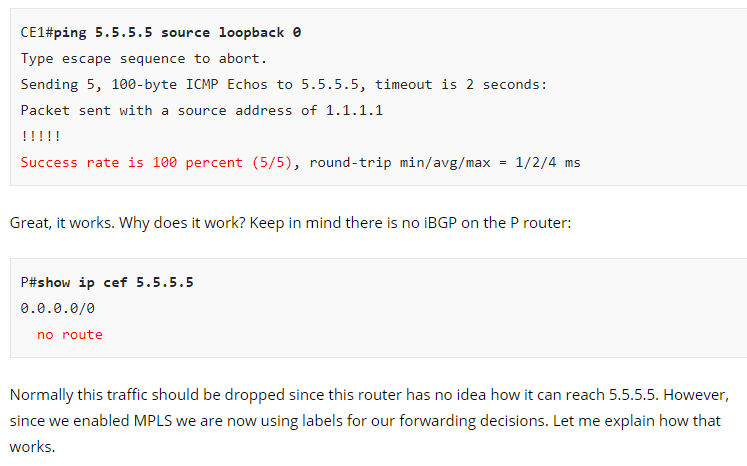Hi Rene ,
I am trying this lab , but IBGP peer using tunnel interfaces is not coming up and i am unable to ping from CE1 to CE2 . Can you please help .
show commands outputs configs attached :
PE1#sho ip route
Codes: C - connected, S - static, R - RIP, M - mobile, B - BGP
D - EIGRP, EX - EIGRP external, O - OSPF, IA - OSPF inter area
N1 - OSPF NSSA external type 1, N2 - OSPF NSSA external type 2
E1 - OSPF external type 1, E2 - OSPF external type 2
i - IS-IS, su - IS-IS summary, L1 - IS-IS level-1, L2 - IS-IS level-2
ia - IS-IS inter area, * - candidate default, U - per-user static route
o - ODR, P - periodic downloaded static route
Gateway of last resort is not set
C 192.168.12.0/24 is directly connected, GigabitEthernet1/0
1.0.0.0/32 is subnetted, 1 subnets
B 1.1.1.1 [20/0] via 192.168.12.1, 00:08:06
2.0.0.0/32 is subnetted, 1 subnets
C 2.2.2.2 is directly connected, Loopback0
3.0.0.0/32 is subnetted, 1 subnets
O 3.3.3.3 [110/2] via 192.168.23.3, 00:08:26, GigabitEthernet0/0
4.0.0.0/32 is subnetted, 1 subnets
O 4.4.4.4 [110/3] via 192.168.23.3, 00:07:57, GigabitEthernet0/0
C 192.168.24.0/24 is directly connected, Tunnel0
C 192.168.23.0/24 is directly connected, GigabitEthernet0/0
O 192.168.34.0/24 [110/2] via 192.168.23.3, 00:08:07, GigabitEthernet0/0
PE1#
-
PE2#sho ip route
Codes: C - connected, S - static, R - RIP, M - mobile, B - BGP
D - EIGRP, EX - EIGRP external, O - OSPF, IA - OSPF inter area
N1 - OSPF NSSA external type 1, N2 - OSPF NSSA external type 2
E1 - OSPF external type 1, E2 - OSPF external type 2
i - IS-IS, su - IS-IS summary, L1 - IS-IS level-1, L2 - IS-IS level-2
ia - IS-IS inter area, * - candidate default, U - per-user static route
o - ODR, P - periodic downloaded static route
Gateway of last resort is not set
2.0.0.0/32 is subnetted, 1 subnets
O 2.2.2.2 [110/3] via 192.168.34.3, 00:08:30, GigabitEthernet0/0
3.0.0.0/32 is subnetted, 1 subnets
O 3.3.3.3 [110/2] via 192.168.34.3, 00:08:30, GigabitEthernet0/0
C 192.168.45.0/24 is directly connected, GigabitEthernet1/0
4.0.0.0/32 is subnetted, 1 subnets
C 4.4.4.4 is directly connected, Loopback0
C 192.168.24.0/24 is directly connected, Tunnel0
5.0.0.0/32 is subnetted, 1 subnets
B 5.5.5.5 [20/0] via 192.168.45.5, 00:08:18
O 192.168.23.0/24 [110/2] via 192.168.34.3, 00:08:30, GigabitEthernet0/0
C 192.168.34.0/24 is directly connected, GigabitEthernet0/0
PE2#
PE2#
PE2#
-
PE1#sho ip bgp sum
BGP router identifier 2.2.2.2, local AS number 1234
BGP table version is 2, main routing table version 2
1 network entries using 132 bytes of memory
1 path entries using 52 bytes of memory
2/1 BGP path/bestpath attribute entries using 296 bytes of memory
1 BGP AS-PATH entries using 24 bytes of memory
0 BGP route-map cache entries using 0 bytes of memory
0 BGP filter-list cache entries using 0 bytes of memory
BGP using 504 total bytes of memory
BGP activity 1/0 prefixes, 1/0 paths, scan interval 60 secs
Neighbor V AS MsgRcvd MsgSent TblVer InQ OutQ Up/Down State/PfxRcd
192.168.12.1 4 10 12 11 2 0 0 00:09:43 1
192.168.23.3 4 1234 0 0 0 0 0 never Active
-
PE2#sho ip bgp sum
BGP router identifier 4.4.4.4, local AS number 1234
BGP table version is 2, main routing table version 2
1 network entries using 132 bytes of memory
1 path entries using 52 bytes of memory
2/1 BGP path/bestpath attribute entries using 296 bytes of memory
1 BGP AS-PATH entries using 24 bytes of memory
0 BGP route-map cache entries using 0 bytes of memory
0 BGP filter-list cache entries using 0 bytes of memory
BGP using 504 total bytes of memory
BGP activity 1/0 prefixes, 1/0 paths, scan interval 60 secs
Neighbor V AS MsgRcvd MsgSent TblVer InQ OutQ Up/Down State/PfxRcd
192.168.24.2 4 1234 0 0 0 0 0 never Active
192.168.45.5 4 20 13 12 2 0 0 00:10:49 1
PE2#
-
Version details:
===============
PE1#sho versio
Cisco IOS Software, 7200 Software (C7200-ADVENTERPRISEK9-M), Version 12.4(20)T, RELEASE SOFTWARE (fc3)
Technical Support: http://www.cisco.com/techsupport
Copyright (c) 1986-2008 by Cisco Systems, Inc.
Compiled Fri 11-Jul-08 04:22 by prod_rel_team
ROM: ROMMON Emulation Microcode
BOOTLDR: 7200 Software (C7200-ADVENTERPRISEK9-M), Version 12.4(20)T, RELEASE SOFTWARE (fc3)
PE1 uptime is 16 minutes
System returned to ROM by unknown reload cause - suspect boot_data[BOOT_COUNT] 0x0, BOOT_COUNT 0, BOOTDATA 19
System image file is "tftp://255.255.255.255/unknown"
CE1.txt (1.9 KB)
CE2.txt (1.9 KB)
P.txt (1.8 KB)
PE1.txt (2.1 KB)
PE2.txt (2.1 KB)
Regards,
Sameer.

